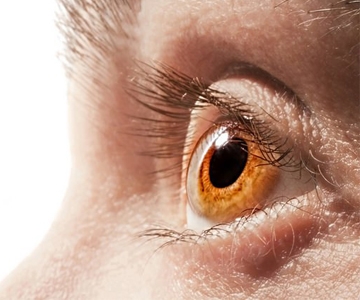Age-related macular degeneration (AMD) is the most common cause of blindness in the UK affecting older people. So, it’s important that any sudden changes to your vision are checked by an optometrist urgently.
What is age-related macular degeneration? AMD is a condition that affects the central part of the vision. It is caused by damage to the macular region
of the eye, which is the part of the retina that provides your detailed vision. It doesn’t normally affect your peripheral (side) vision, so while objects in the centre of your vision may become difficult to see, the vision to the side and edges should not be affected.
There are two main types of AMD – dry and wet. Dry AMD, sometimes referred to as wear and tear, is caused by a build-up of waste within the cells of the eye that react to light, these are called drusen. Drusen stop the cells from reacting properly to light. This form of AMD usually develops slowly.
Wet AMD happens when new blood vessels grow behind the macula. These blood vessels can begin to leak and this can damage the cells in the macula region and stop them from working. This process can start very suddenly.
Risk factors
Age is the main risk factor for developing AMD and the disease is more common in people over 65.
Smoking significantly increases the risk of getting macular degeneration. So, stopping smoking is the greatest change you can make to protect yourself from AMD. Ultra Violet (UV) light may also increase the risk of AMD. So, it’s a good idea to always wear glasses that block or absorb UV light whenever there’s a risk of exposure to reduce the likelihood of developing AMD. Eating a healthy diet, with lots of fruit and vegetables can help to protect your eyesight
– kale, spinach and broccoli all contain nutrients that have been shown to help keep the eyes healthy. If you have a close relative with AMD, your risk of developing the condition is higher.
Symptoms
To begin with, dry AMD may have little effect on your vision. If the disease develops, your central vision may gradually become more blurred and it may become difficult to recognise faces and read things directly in front of you.
Wet AMD will normally cause distorted vision, with straight lines and edges such as door frames becoming wavy and distorted. Some people also see a sudden blank spot in their central vision. Sometimes these changes can happen quickly and if so you should see an optometrist urgently.
Treatment
At present there is no treatment for dry AMD. It may be possible to see better with the help of special magnifiers and good lighting.
If it is caught early, wet AMD can be treated with injections into the eye. The injections work by stopping the growth of new blood vessels and can help to save your vision and reduce the risk of the disease getting any worse. Treatment for wet AMD needs to be given quickly to stop further blood vessels forming in the eye and reduce the risk of the disease getting any worse. If you notice any change in symptoms, you should contact your optometrist immediately.

